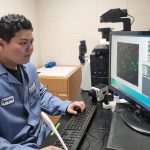Researchers Create Nanoparticle with ‘Look and Feel’ of Red Blood Cells to Soak up Toxins

Red blood cells not only carry oxygen from one part of the body to another, they also act as sponges in the circulatory system, soaking up toxins such as poisons shed from infections. The more red blood cells available in the blood system, the faster the recovery from toxin-related threats to the body.
Johns Hopkins biomedical engineer Jordan Green, Ph.D., and his colleagues have developed a nanoparticle that has the shape and “skin” of red blood cells. The red blood cell mimics can be injected into the bloodstream and circulate within vessels for long periods to absorb toxic substances.
A report on the work appears in the April 15, 2020, issue of the journal Science Advances.
Green says that other research groups have developed sphere-shaped nanoparticles as toxic sponges, but his team found that more closely matching the shape of the oxygen-carrying cells is a critical step forward.
“Most nanoparticles are spheres, but we hypothesized that mimicking the elongated shape of red blood cells may work better — in part because it has more surface area — to absorb toxins,” says Green, professor of biomedical engineering, ophthalmology, oncology, neurosurgery, materials science and engineering, and chemical and biomolecular engineering at the Johns Hopkins University School of Medicine and a member of the Johns Hopkins Kimmel Cancer Center.
First author Elana Ben-Akiva, Green and the Johns Hopkins team used biodegradable plastic-coated nanoparticles and stretched them to create elongated shapes. Then, they wrapped the lengthened nanoparticles in the membranes, or outer coating, of mouse red blood cells.
Next, the team injected the newly created nanoparticles into mice that had a lethal dose of alpha-toxin from the Staphylococcus aureus bacteria to evaluate the ability of the nanoparticles to serve as a sepsis detoxification therapy. Sepsis is a fatal condition caused by the release of toxins from bacteria into the bloodstream.
Compared with uncoated, spherical nanoparticles, Green and his team found that their red blood cell-mimicking nanoparticles stayed approximately 600% longer in the bloodstream of mice before being engulfed by immune system cells. Half of the toxin-laden mice survived long term — meaning more than one week after being treated — with the newly created nanoparticles, compared with a survival time of only several hours for mice in the control group.
“The more we learn about biology, the more we can engineer treatments to match it, and the better our treatments work,” says Green.
Story by the Johns Hopkins Medicine Newsroom and posted on April 16, 2020.





